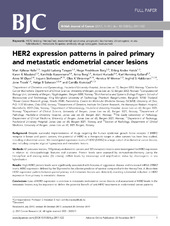| dc.contributor.author | Halle, Mari Kyllesø | en_US |
| dc.contributor.author | Tangen, Ingvild Løberg | en_US |
| dc.contributor.author | Berg, Hege Fredriksen | en_US |
| dc.contributor.author | Hoivik, Erling A | en_US |
| dc.contributor.author | Mauland, Karen Klepsland | en_US |
| dc.contributor.author | Kusonmano, Kanthida | en_US |
| dc.contributor.author | Berg, Anna | en_US |
| dc.contributor.author | Hurtado, Antoni | en_US |
| dc.contributor.author | Kalland, Karl-Henning | en_US |
| dc.contributor.author | Øyan, Anne Margrete | en_US |
| dc.contributor.author | Stefansson, Ingunn | en_US |
| dc.contributor.author | Vintermyr, Olav Karsten | en_US |
| dc.contributor.author | Werner, Henrica Maria Johanna | en_US |
| dc.contributor.author | Haldorsen, Ingfrid S. | en_US |
| dc.contributor.author | Trovik, Jone | en_US |
| dc.contributor.author | Salvesen, Helga Birgitte | en_US |
| dc.contributor.author | Krakstad, Camilla | en_US |
| dc.date.accessioned | 2017-12-05T14:28:05Z | |
| dc.date.available | 2017-12-05T14:28:05Z | |
| dc.date.issued | 2017-11-23 | |
| dc.identifier.issn | 1532-1827 | |
| dc.identifier.issn | 0007-0920 | |
| dc.identifier.uri | https://hdl.handle.net/1956/16983 | |
| dc.description.abstract | Background: Despite successful implementation of drugs targeting the human epidermal growth factor receptor 2 (HER2) receptor in breast and gastric cancers, the potential of HER2 as a therapeutic target in other cancers has been less studied, including endometrial cancer. We investigated expression levels of HER2 (ERBB2) in a large cohort of endometrial cancer lesions, also including complex atypical hyperplasia and metastatic lesions. Methods: 67 precursor lesions, 790 primary endometrial cancers and 383 metastatic lesions were investigated for HER2 expression in relation to clinicopathologic features and outcome. Protein levels were assessed by immunohistochemistry (using the HercepTest and staining index (SI) criteria), mRNA levels by microarrays and amplification status by chromogenic in situ hybridisation. Results: High HER2 protein levels were significantly associated with features of aggressive disease and increased mRNA ERBB2 levels. HER2 expression defined by the SI proved to be a better predictor of survival compared with the HercepTest. A discordant HER2 expression pattern between paired primary and metastatic lesions was detected, revealing substantial reduction in HER2 expression from primary to metastatic disease. Conclusions: Loss of HER2 expression is common in metastatic endometrial cancer lesions and assessment of HER2 levels in the metastatic lesions may be important to define the potential benefit of anti-HER2 treatments in endometrial cancer patients. | en_US |
| dc.language.iso | eng | eng |
| dc.publisher | Nature Publishing Group | eng |
| dc.relation.ispartof | <a href=" http://hdl.handle.net/1956/16984" target="blank"> Molecular alterations suggesting new treatment strategies in uterine carcinomas</a> | |
| dc.rights | Attribution-NonCommercial-Share Alike CC BY-NC-SA | eng |
| dc.rights.uri | https://creativecommons.org/licenses/by-nc-sa/4.0/ | |
| dc.subject | HER2 testing | eng |
| dc.subject | HercepTest | eng |
| dc.subject | endometrial carcinoma | eng |
| dc.subject | prognostic biomarkers | eng |
| dc.subject | chromogenic in situ hybridisation | eng |
| dc.subject | metastatic biopsies | eng |
| dc.subject | antibody-drugs conjugate | eng |
| dc.subject | trastuzumab | eng |
| dc.title | HER2 expression patterns in paired primary and metastatic endometrial cancer lesions | en_US |
| dc.type | Peer reviewed | |
| dc.type | Journal article | |
| dc.description.version | publishedVersion | en_US |
| dc.rights.holder | Copyright 2017 Cancer Research UK. | |
| dc.identifier.doi | https://doi.org/10.1038/bjc.2017.422 | |
| dc.source.journal | British Journal of Cancer | |

